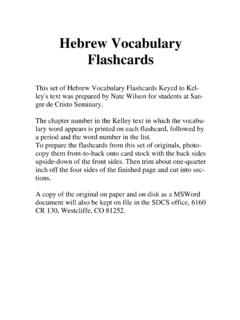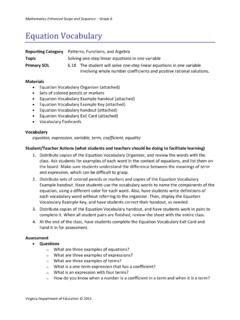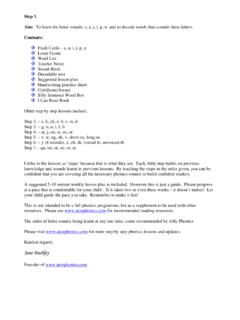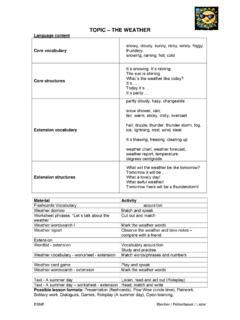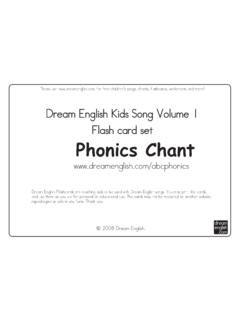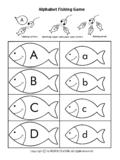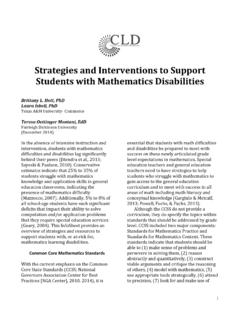Transcription of Phonics Primer - NRRF
1 Phonics Primer You can use this Phonics Primer developed by The National Right to Read Foundation to begin teaching a child or adult to read today. This Primer lists the 44 sounds in the English language and then gives steps for teaching those 44. sounds and their most common spelling patterns. In addition to learning sounds and spellings, each day the student must read lists of phonetically related words and spell these words from dictation. Phonics instruction must be reinforced by having the student read decodable text. The 44 Sounds in the English Language 5 Short-Vowel Sounds 18 Consonant Sounds 7 Digraphs short / / in apple /b/ in bat /ch/ in chin short / / in elephant /k/ in cat and kite /sh/ in ship short / / in igloo /d/ in dog unvoiced /th/ in thin short / / in octopus /f/ in fan voiced /th/ in this short / / in umbrella /g/ in goat /hw/ in whip *.
2 /h/ in hat /ng/ in sing /j/ in jam /nk/ in sink /l/ in lip /m/ in map * (wh is pronounced /w/ in /n/ in nest some areas). /p/ in pig /r/ in rat /s/ in sun /t/ in top /v/ in van /w/ in wig /y/ in yell /z/ in zip 6 Long-Vowel Sounds 3 r-Controlled Vowel Diphthongs and Other Sounds Special Sounds long / / in cake /ur/ in fern, bird, and hurt /oi/ in oil and boy long / / in feet /ar/ in park /ow/ in owl and ouch long / / in pie /or/ in fork short / / in cook and pull long / / in boat /aw/ in jaw and haul long / / (yoo) in mule /zh/ in television long / / in flew Developed by Sandra Elam page 1. The National Right to Read Foundation, Steps for Teaching Phonics Step 1. Gather the materials listed below and store them together in a box.
3 Materials for Teaching Phonics What You Need Suggestion systematic Phonics program Consider a program from Phonics Products for Home or Phonics Products for School. * Phonics flashcards with the Consider the Individual Set of 70 Phonogram Cards (item letter or letter combination (such #IPC, $10) from Spalding Education International, available as ou) on front and clue word at It's helpful to also purchase the (such as out) on back Spalding Phonogram Sounds CD (item #CD, $ ) to learn how to pronounce each sound correctly. decodable stories If your Phonics program does not contain 100% decodable (preferably 100% decodable) stories, consider the 17-book set of readers from the Sing, Spell, Read, & Write program.
4 These books (called 2nd Edition 1st Grade Storybooks) can be purchased individually or as part of the Level 1 program by visiting the publisher Pearson Learning at . writing supplies: index cards, Purchase writing supplies at any office supply store. index card file, black wide-tip permanent marker, beginner's wide-ruled writing tablet, 2. pencils with erasers * Note: Make sure your Phonics flashcards give the proper sound or sounds for each letter or letter combination many widely available flashcards are incorrect or incomplete. For example, the common sound of x is /ks/ as in fox, not /z/ as in xylophone or /eks/ as in x-ray. Also, the short-vowel sound of i is / / as in igloo, not / / as in ice cream.
5 Developed by Sandra Elam page 2. The National Right to Read Foundation, Step 2. Teach the 5 short-vowel sounds and consonant sounds. Drill until memorized. During the first week, use the flashcards to drill the short-vowel sounds. Add several consonant sounds each day until you are drilling all short-vowel sounds and consonant sounds with your student daily. Do not rush this step. Keep drilling until all sounds are memorized, which usually takes 2-4 weeks. Tip: Work on Phonics for at least 15 minutes a day, 5 days a week with your student. Frequency and consistency are more important than the length of time spent on each lesson. Short-Vowel Sounds short / / in apple short / / in elephant short / / in igloo short / / in octopus short / / in umbrella Consonant Sounds /b/ in bat /k/ in kite /s/ in sun /k/ in cat /l/ in lip /t/ in top /d/ in dog /m/ in map /v/ in van /f/ in fan /n/ in nest /w/ in wig /g/ in goat /p/ in pig /ks/ in fox /h/ in hat /kw/ in queen /y/ in yell /j/ in jam /r/ in rat /z/ in zip Developed by Sandra Elam page 3.
6 The National Right to Read Foundation, Step 3. Practice two-letter blends. Drill until blending is automatic. After your student knows the short-vowel sounds and consonant sounds, next teach him how to orally blend two letters (b-a, ba) and read two-letter blends such as: ba, be, bi, bo, bu. Two-Letter Blends b + a = ba s + a = sa j + a = ja b + e = be s + e = se j + e = je b + i = bi s + i = si j + i = ji b + o = bo s + o = so j + o = jo b + u = bu s + u = su j + u = ju Step 4. Practice three-letter blends. Drill until blending is automatic. After your student can read two-letter blends, progress to three-letter blends, that is, words. Each day, have your student read a set of short-vowel words, then dictate these same words to him.
7 (Show him how to form each letter and correct him gently, if necessary). This not only helps him remember the Phonics lesson just learned, but it greatly improves spelling. Golden Rule of Phonics : Never allow your student to skip, guess, or substitute words. Accuracy is more important than speed. Three-Letter Blends fa + t = fat ki + t = kit ro + d = rod de + n = den ma + d = mad se + t = set bo + x = box ye + s = yes tu + g = tug hi + d = hid no + t = not wi + n = win ju + g = jug pu + n = pun la + p = lap Developed by Sandra Elam page 4. The National Right to Read Foundation, Step 5. Teach the twin-consonant endings, plurals, and two-consonant blends. Drill until blending is automatic. Twin-Consonant Endings Two-Consonant Blends Two-Consonant Blends puff blab stun, fist sell brag swam kiss club trot fuzz crop twin lock drag fact fled raft Plurals: frog bulb cats (sounds like /s/) glum held beds (sounds like /z/) grip elf plug sulk prim film scat help skip, mask silt sled jump smug hand snip mint spot, gasp kept Developed by Sandra Elam page 5.
8 The National Right to Read Foundation, Step 6. Teach the digraphs (ch, sh, th, wh, ng, nk). A digraph consists of two consonants that form a new sound when combined. Also teach three- consonant blends. Digraphs Three-Consonant Blends chin, such, patch (silent t) scruff ship, wish split thin, with (unvoiced /th/) strap this (voiced /th/) thrill whip sang, sing, song, sung sank, sink, honk, sunk Developed by Sandra Elam page 6. The National Right to Read Foundation, Step 7. Introduce a few high-frequency words necessary to read most sentences. After your student can read three-letter and four-letter words easily, it's time to add a few high- frequency words that are necessary to read most sentences.
9 Some high-frequency words are phonetically regular (such as or ), but are introduced out of sequence because of their importance. Other words are truly irregular, because they contain one or more letters that don't follow the rules of Phonics (such as once and who ). The Basic High-Frequency Words table lists the most important words. Write each word on an index card. Introduce three or four new words a week. Drill your student on these words everyday, encouraging him to sound out as much of the word as possible (usually the vowel sound is the only irregular part). As your student masters each word, file the card in the card file under Words I Know. When your student comes across a new wacky word (such as sugar in which the s is pronounced /sh/), make up a new index card and file it under Words To Learn.
10 Tip: What distinguishes this high-frequency word list from the typical sight word list? Many words in the list below cannot be completely sounded out, either because they contain one or more letters that don't follow the rules or the rule is learned later. In contrast, the typical sight word list contains mostly phonetically regular words (such as and and when ) that the student is forced to memorize simply because he has never been taught to sound them out. Basic High-Frequency Words Introduce after student can Introduce after student can read short-vowel words, /th/, and /sh/ read long-vowel words A vowel by itself says its name: was, were, are a, I doing, does said, says, have, give e at the end of a short word says its name: you, your, yours be, he, me, we, she, the*.
